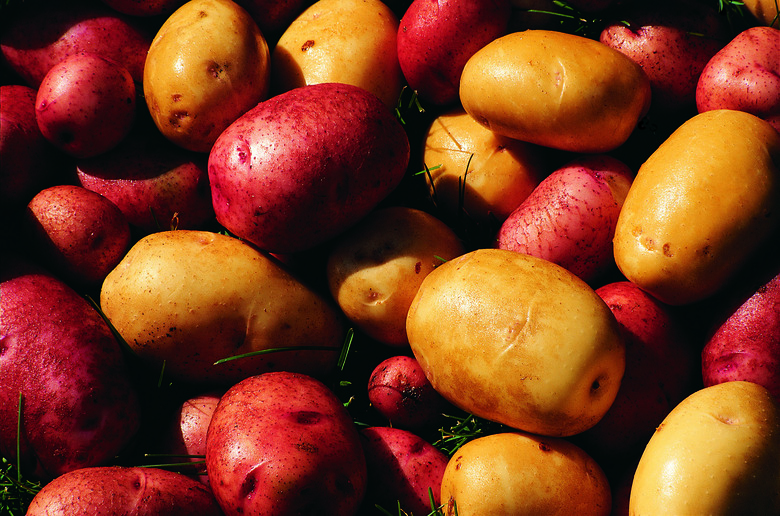How To Grow Potatoes In Aquaponics
Things Needed
- Plastic fish pond
- Drill with 1-inch spade bit
- 5-gallon bucket with lid
- Pea gravel
- 3 plastic garbage cans
- Pond pump
- Plastic tubing, 1-inch diameter
- Perlite
- Coconut coir
- Vermiculite
- Cement blocks
Aquaponics is a method of growing fruits and vegetables in a hydroponic system combined with the aqua-culture of fish. While most aquaponics systems use the water culture system, potatoes thrive when grown in a wick-style hydroponic system. By building a closed system of recirculating water and nutrients, the aquaponic system serves a dual purpose — cleaning the pond water and nourishing the potatoes.
Step 1
Set up a plastic fish pond according to the manufacturer's directions. Add water to the fill line and allow it to sit 24 to 48 hours so the chlorine in the water completely evaporates.
Step 2
Drill a 1-inch-diameter hole for plastic tubing in the side of a 5-gallon bucket, 4 inches from the top. Also drill a hole through the lid of the bucket at the same diameter as the pump tubing.
- Aquaponics is a method of growing fruits and vegetables in a hydroponic system combined with the aqua-culture of fish.
- By building a closed system of recirculating water and nutrients, the aquaponic system serves a dual purpose — cleaning the pond water and nourishing the potatoes.
Step 3
Place the bucket on an upside-down garbage can next to the fish pond. Attach a 3-foot length of 1-inch plastic tubing to the hole in the side, using silicone sealant to seal around the hole. Allow the silicone to dry completely. Fill the bucket with clean gravel.
Step 4
Place the lid on the bucket and push the pump tubing through the hole. Seal with silicone sealant and allow to dry. This bucket becomes the bioreactor, removing the ammonia from the fish waste through bacterial action.
- Place the bucket on an upside-down garbage can next to the fish pond.
- Place the lid on the bucket and push the pump tubing through the hole.
Step 5
Nest two plastic garbage cans together. Measure the distance between the tops of the two cans and add 1 inch to the measurement. Separate the garbage cans.
Step 6
Mark the measurement on the side of one garbage can. Drill a 1-inch hole through the side of the can. This can becomes the reservoir for the hydroponic system.
Step 7
Turn the second garbage can upside down. Drill 10 to 15 1/2-inch diameter holes in the bottom of the can. Line the bottom with fiberglass window screening. This becomes the planter.
- Nest two plastic garbage cans together.
- Turn the second garbage can upside down.
Step 8
Place the reservoir on cement blocks next to the fish tank and bioreactor, with the hole in the side facing the fish pond. Attach a 3-foot length of tubing to the side of the can, sealing it with silicone sealant. Allow it to dry completely. Place the other end of the tubing in the fish pond.
Step 9
Set the planter inside the reservoir. Place the end of the bioreactor hose in the top of the planter. Raise the base of the bioreactor with cement blocks if necessary so the water will drain freely into the planter.
- Place the reservoir on cement blocks next to the fish tank and bioreactor, with the hole in the side facing the fish pond.
- Place the end of the bioreactor hose in the top of the planter.
Step 10
Plug in a pond pump and start pumping water into the bioreactor. Allow it to fill the bioreactor and drain into the planter until water comes out of the tubing in the reservoir, returning to the fish pond.
Step 11
Add fish to the pond. Generally, shrimp, crayfish or tilapia are grown in food-producing aquaculture systems. Allow the system to run for one to two weeks before planting the potatoes.
Step 12
Rinse perlite thoroughly and mix equal parts perlite, coconut coir and vermiculite. Fill the planter one-quarter full with the planting mix. Place six seed potatoes in the planter and cover with 2 inches of planting mix.
- Plug in a pond pump and start pumping water into the bioreactor.
- Place six seed potatoes in the planter and cover with 2 inches of planting mix.
Step 13
Add more planting mix as the potato vines grow, covering all but the last two sets of leaves. When the vines reach the top of the planter, allow them to grow freely. Harvest the potatoes when the vines die back in the fall.
Tip
Place the aquaculture system in full sun or under grow lights. Potatoes require six to eight hours of direct sun daily. Feed the fish a high-quality fish food. Monitor the ammonia level in the tank. Kits are available at home garden centers and shops specializing in pond culture. Many fruits and vegetables are grown in a water culture system instead of a wicking system.
Warning
Plug the pond pump into a GFCI-protected outlet. Cover the fish pond with a steel mesh or other protective covering if you have children. Children can drown in 1 inch of water. Support all parts of the system with cement blocks or other sturdy supports; water is heavy.
